Complete Texas Weed Identification Guide
(Various species)
FREE QUOTE
Request Your Free, No Obligation Quote
![]() Average rating of 5.0 out of 5 stars from 134 reviews. Read Google Reviews
Average rating of 5.0 out of 5 stars from 134 reviews. Read Google Reviews
Common Weeds in Texas Lawns and Landscapes
Weeds are more than just a cosmetic issue in your lawn. In Texas, especially in North Texas, weeds compete with turfgrass for nutrients, water, and space-weakening your lawn, inviting pests, and decreasing curb appeal. At Trees Hurt Too Inc., we help homeowners and property managers identify and treat the most common Texas weeds to restore health and beauty to their landscapes.
Why Weed Identification Matters
Proper weed control begins with accurate identification. Every weed species behaves differently. Some thrive in compacted soil, others in shade. Some are resistant to common herbicides and require targeted treatments. Misidentifying a weed can lead to wasted time, money, and continued lawn damage.
For example, treating a sedge like nutsedge with a standard broadleaf herbicide won’t produce results. Similarly, pre-emergents need to be applied at the right time of year to effectively control seasonal weeds like crabgrass or henbit. Our trained technicians use regional knowledge, timing, and integrated pest management (IPM) principles to ensure precise results.
Accurate identification also helps prevent unintended turf damage. Certain herbicides may kill desirable grasses or leave behind harmful residue if misapplied. We ensure targeted control using the least amount of chemical needed to get the job done safely and effectively.
At Trees Hurt Too Inc., we provide weed control services across the state including:
- North Texas: Dallas, Fort Worth, Keller, Southlake
- Central Texas: Waco, Temple, Killeen
- South Texas: San Antonio, McAllen, Laredo
We evaluate both what you see above the surface and what’s happening in your soil, providing long-term solutions-not just quick fixes.
Common Lawn Weeds in Texas
Texas lawns face a unique mix of invasive and nuisance weeds. Our list below outlines some of the most common types of weeds we encounter in residential and commercial properties, along with how to spot and treat them.
1. Dallisgrass (Paspalum dilatatum)
This aggressive weed is particularly problematic in warm-season lawns. Dallisgrass thrives in compacted soils and quickly overtakes thin or stressed turf. Its seed heads appear early and persist into late summer.
- Type: Perennial grassy weed
- Appearance: Coarse, upright clumps with wide blades and long seed heads with black specks
- Region: Statewide, especially in North Texas cities like Dallas and McKinney
- Control Tip: Post-emergents such as MSMA (where legal) or Dallisgrass-specific herbicides are required. Aeration and consistent fertilization help create dense turf to resist invasion.

2. Crabgrass (Digitaria spp.)
A widespread nuisance, crabgrass germinates as soil temperatures warm in spring. It invades bare spots and can quickly dominate areas not treated with pre-emergents.
- Type: Annual grassy weed
- Appearance: Low, sprawling grass with coarse, wide blades and finger-like seed heads
- Region: Found throughout Texas, most prevalent in North and Central regions
- Control Tip: A pre-emergent like prodiamine applied in early spring offers excellent prevention. Spot treatment with quinclorac is effective post-emergence.
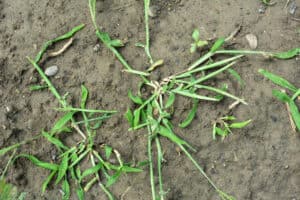
3. Nutsedge (Cyperus spp.)
Often mistaken for regular grass, nutsedge grows faster than turf and creates uneven patches. It reproduces through underground tubers called nutlets, making it especially hard to control.
- Type: Perennial sedge
- Appearance: Grass-like with a triangular stem and glossy green leaves; yellow or purple seed heads depending on species
- Region: Found in wet, low-lying areas or over-irrigated lawns
- Control Tip: Manual removal is ineffective due to deep-rooted nutlets. Selective sedge herbicides and reduced watering are key to long-term suppression.
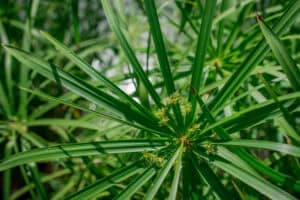
4. Clover (Trifolium spp.)
While some homeowners tolerate clover, others view it as an unwanted invader. It spreads easily in under-fertilized lawns and attracts bees with its blossoms.
- Type: Broadleaf perennial
- Appearance: Three rounded leaflets per stem with white, pink, or red flowers
- Region: Statewide, especially where soil nitrogen is low
- Control Tip: Apply high-nitrogen fertilizer to promote grass dominance. Use a broadleaf herbicide such as 2,4-D for effective control.
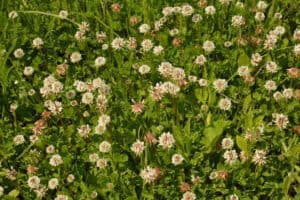
5. Spurge (Euphorbia spp.)
Spurge thrives in hot, dry areas and often appears in sidewalk cracks, mulch beds, and around driveways. It is one of the most heat-tolerant lawn weeds.
- Type: Annual broadleaf
- Appearance: Low-growing mat with red stems, small oval leaves, and milky sap when damaged
- Region: Widespread across Texas, especially North and Central regions
- Control Tip: Early spring pre-emergents reduce spread. Remove by hand before flowering. Post-emergent broadleaf herbicides work well.
6. Chickweed (Stellaria media)
This cool-season weed prefers shaded, moist areas and can carpet entire lawns if not addressed. It emerges in fall and persists through early spring.
- Type: Cool-season annual
- Appearance: Tiny white star-shaped flowers and teardrop leaves; forms dense mats
- Region: Common in shaded North Texas yards and gardens
- Control Tip: Apply a fall pre-emergent. Spot treat with selective post-emergent for broadleaf weeds. Reseed or overseed weak areas to strengthen turf.

7. Henbit (Lamium amplexicaule)
Henbit is part of the mint family and spreads by both seeds and stems. It quickly takes over in early spring before lawns green up.
- Type: Broadleaf winter annual
- Appearance: Square stems with scalloped leaves and tubular purple flowers
- Region: Common in lawns, fields, and roadside areas throughout Texas
- Control Tip: Pre-emergent control in fall (October) is most effective. Use a 3-way herbicide blend to treat visible patches.
8. Purslane (Portulaca oleracea)
Purslane is a succulent weed that tolerates extreme drought. It grows flat across surfaces and is known to be edible, though undesirable in manicured turf or beds.
- Type: Succulent broadleaf annual
- Appearance: Reddish stems, round fleshy leaves, and small yellow flowers
- Region: Found statewide but thrives in South and Central Texas dry zones
- Control Tip: Hand-pull early in season. Use thick mulch in beds. For turf areas, apply a post-emergent labeled for succulent weeds.
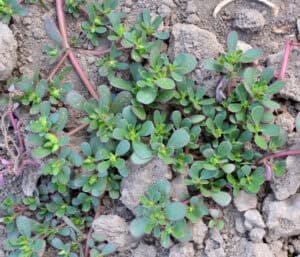
Regional Weed Identification Variants
While many weeds grow throughout Texas, some are more problematic in specific regions. Factors like temperature, rainfall, soil type, and grass species influence what grows where.
North Texas Weeds
Characterized by clay-heavy soils and variable rainfall, North Texas lawns are prone to Dallisgrass, crabgrass, henbit, and spurge. Shaded lawns often suffer from chickweed and clover as well.
Central Texas Weeds
With limestone-based soil and hotter average temps, Central Texas deals with nutsedge, thistle, curly dock, and chickweed. Irrigation plays a role in weeds like nutsedge taking over.
South Texas Weeds
Hot, arid conditions and sandy soils make this region a haven for purslane, sandbur, and plantain. Weeds here are drought-tolerant and often spiny or succulent.
Texas Pasture Weeds
Weeds such as ragweed, pigweed, broomweed, Texas thistle, and bitterweed commonly impact pastures and ranch properties. Many of these are toxic to livestock or reduce hay quality.
Targeting regional weeds with tailored control methods ensures better results and helps preserve soil health.
When to Call for Professional Weed Control
DIY herbicides can be useful for minor issues, but serious infestations often return without expert help. Homeowners may misapply products, choose the wrong treatment window, or overlook soil deficiencies contributing to weed growth.
Our Expert Services Include:
- Accurate species identification based on regional weed databases
- Tailored herbicide treatments based on your lawn's grass type and weed pressure
- Soil testing and amendments to adjust pH and fertility levels
- Scheduled pre- and post-emergent treatments to prevent seasonal outbreaks
- Safe, low-toxicity formulas that are family- and pet-friendly
Our approach emphasizes sustainable control, meaning fewer chemicals over time, healthier lawns, and better resilience against weed resurgence.
Get Help with Weed Control in Texas
Whether you’re battling grassy invaders or persistent broadleaf weeds, Trees Hurt Too Inc. offers expert weed identification and treatment services throughout Texas. Our trained team will diagnose your weed problems, tailor a treatment plan to your lawn, and deliver consistent results-season after season.
Contact us today to schedule your lawn inspection and take the first step toward a healthier, weed-free landscape.
Are weeds dangerous?
Weeds are unwanted in our yards for many reasons, including their ability to attract stinging insects, reduce our wanted plants' viability, and act as resting spots for unwanted insects like mosquitoes.
Weeds are also well known for ruining the aesthetics of lawns and taking away your lawn's ability to gain nutrients from the soil and the sun's light. While weeds may not be a problem out in nature, when they find a way to our yards, they take over and become difficult to control and eliminate!
In addition to ruining the look of your yard, another issue with weeds is that many people are allergic to them. Weeds can cause skin allergies and symptoms like runny noses and eyes.
Why do I have a weed problem?
You have a problem with weeds because they can take over whatever space they end up in. Weeds grow fast, much faster than grass, using up the nutrients available in the soil. Things like bare spots and unfertilized grass may make a lawn more attractive to weeds.
Some other reasons weeds quickly become a problem in our Texas yards include:
- They produce massive amounts of seeds.
- Their seeds can remain dormant until environmental conditions are right for them to grow.
- Weeds grow and thrive, even when we have disturbed the ground.
Where will I find weeds?
You can and will find weeds almost anywhere. There is a weed for every location and environmental condition. If your yard is sunny, shady, dry, or wet, there is a weed that will grow.
- Dandelion grows best in sunny, moist areas.
- Dallisgrass grows best in wet areas like drain ditches, low lying areas, and in heavily irrigated yards.
- Virginia buttonweed is a deep-rooted weed that prefers very damp soil.
- Spurge grows in open, sunny areas and can tolerate dry soil.
How do I get rid of weeds?
How can I prevent weeds in the future?
Limit the chances of your yard becoming overrun with weeds with the following prevention tips:
- Mow your lawn's grass to its ideal height.
- Keep your lawn well irrigated.
- Re-seed bare spots in your yard to prevent weeds from utilizing the space.
- Make sure to properly fertilize your grass, so it stays as healthy and dense as possible.
- Use mulch in garden areas to help deprive weeds of the sun they need to grow.
- Partner with a professional and take a proactive approach to weeds, stopping them before they take over your Texas yard!
Service Area
LATEST BLOGS
Stay informed about lawn care, tree care and pest related issues in your area!
In the vivid tapestry of our gardens, trees stand as towering sentinels, offering shade, beauty, and life. Yet, these majestic […]
As the golden leaves of fall begin to blanket our gardens, signaling the end of another growing season, it’s essential […]
There’s nothing quite like the sight of a majestic tree adorning your landscape. But when those once-vibrant leaves start to […]

